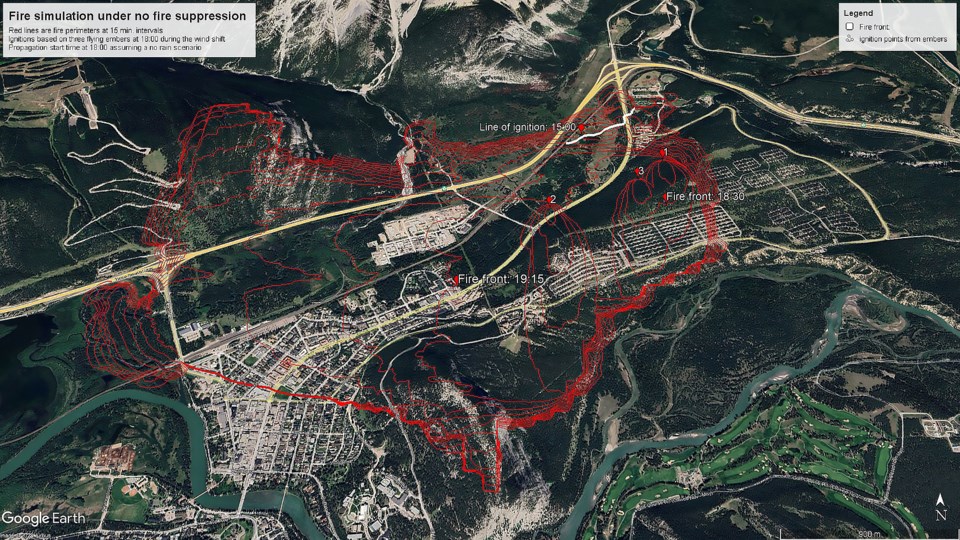Shortly after the escaped prescribed fire of May 3, I wrote an unsolicited, science-based critical review of the incident and submitted it to Banff National Park superintendent Sal Rasheed, Town of Banff council and the Banff Fire Chief. I received a response from Coun. Barb Pellam and a stock response letter from the superintendent.
The primary concerns stem from the results of a Prometheus fire simulation and are serious enough to prompt me to share them with residents of the Bow Valley. This letter is about raising awareness of the town’s vulnerability to wildfire and that Parks Canada needs to conduct a transparent, third-party review of what unfolded that day ranging from ignored science and common sense, to operational oversights and lack of communication. In addition, the Town of Banff needs to conduct its own review in terms of trust and reliance on Parks, how it will evaluate fire risk going forward, and its communication strategy through the Voyent Alert, which seriously downplayed fire risk to residents and campers on Tunnel Mountain.
On the day of the fire, we had severe drought conditions, with a significant amount of dead grass and dry leafless shrubs and aspen trees. By 1 p.m. there were looming thunderheads building, which would eventually bring turbulent winds and shifts in wind directions. Relative humidity was also lower than the air temperature, something called “crossover” in the fire world, which leads to conditions of accelerated combustion and aggressive fire behaviour. Add moderate winds to the mix, and we have rapid fire spread both on the ground and the crown of trees. Under such conditions, firefighting with boots on the ground becomes inefficient and dangerous and it switches to an aerial firefighting exercise.
The fire simulation shown is based on the conditions of that day, but excludes the fortuitous rain shower that fell over the fire and the town when a thunderstorm passed through. This is a what-if scenario as Prometheus is not designed to account for fire suppression. So, simply imagine these ignitions to be from lightning strikes, or other human activity, and see how quickly the town is in trouble. And, in light of the recent thick smoke, also imagine how difficult a fire start could be detected.
The simulation assumes three random points of ignition from flying embers coinciding with a wind shift from the north that occurred at 6 p.m. with the advance of the thunderstorm, and which shifted again from the east with gusty winds by 7 p.m. Ember ignitions were positioned based on where the fire was burning between 3 p.m. and 4 p.m. when it crossed Banff Avenue and spread into the horse corrals and cemetery. Each red line represents the position of the fire front at 15-minute intervals.
Because fire accelerates going up-slope, it takes only 45 minutes for ignitions one and three to reach the campground, and by 7:15 p.m. the fire front is at the Husky station from ignition two. Given the number of coniferous trees we have and the flammable nature of buildings, fire could move rapidly through town. The small comfort is Prometheus tends to over-burn or amplify the rate of fire spread, so perhaps there could be an extra hour of breathing room for evacuation measures. However, the wind speeds used varied between 20 and 30 km/h, which are moderate when thinking how frequently the Bow Valley is subjected to stronger winds.
The town is surrounded by vast extents of highly flammable coniferous forests set in narrow valleys and steep terrain – two features that increase the rate of fire spread. Fire ignitions can come from any side of town, and the simulation shows that fire threat doesn’t have to come from kilometres away. The large number of mature spruce trees through town is still very problematic from a fire risk perspective and the newly planted spruce and pine trees in the core area won’t help any when those trees grow to rooftop height. I raised this issue in 2018 with the urban planning division and the fire chief.
Going forward, I am still very supportive of the prescribed burn program from both an ecological restoration standpoint and fire hazard mitigation, but burning a small meadow between two highways in proximity to town seems trivial. Burning grass and shrubs do not contribute to a fire guard. Grazing, on the other hand, keeps the grass short and is also a form of natural disturbance with ecological value.
Regionally, very few fire-scarred trees are found around meadows indicating meadow-only fires. Most scars are associated with stand-replacing forest fires and there is no good justification to carry-out such burns near town. The best fire guards are from logging and thinning forests around towns, similar to Jasper. Notwithstanding ecological, legal and political issues, a parking lot next to the Husky station, in lieu of a mature spruce forest, makes for the best, simple and most cost-effective fire guard.
So much more needs to be done to FireSmart in and around town as our fire risk is still very high. Severe drought conditions will become more normal and there is a strong likelihood homes and businesses will be lost no matter what. The more we stack the odds on our side the better, and emergency preparedness needs to be adjusted accordingly.
Marie-Pierre Rogeau has 32 years of experience in fire research and is a fire ecologist living in Banff. Her Masters degree researched the fire history of Banff National Park and her PhD focused on fire regimes and the effect of topography on fire frequency in the Rockies.




